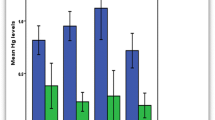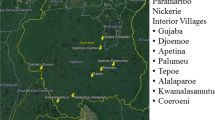Abstract
Hair mercury (HHg) concentration is a biomarker of exposure that is widely used to assess environmental contamination by fish methylmercury and neurodevelopment in children. In the Rio Madeira basin (Brazilian Amazon), total HHg concentrations in 649 mother–infant pairs were measured at birth (prenatal exposure) and after 6 months of exclusive breastfeeding; these mother–infant pairs were from high fish-eating communities (urban, n = 232; rural, n = 35; and Riverine, n = 262) and low fish-eating tin-miner settlers (n = 120). Differences in kinetics were seen between Hg exposure from fish consumption and environmental exposure to a tin-ore mining environment. Overall maternal HHg concentrations (at childbirth and after 6 months of lactation) were higher than those of infant HHg. However, the relative change in HHg after 6 months of lactation showed that mothers decreased HHg while infants increased HHg. The relative change showed a consistently higher increase for girls than boys with a statistical significance only in high fish-eating mothers. The correlation coefficients between maternal and newborn hair were high and statistically significant for mothers living in urban (r = 0.66, p < 0.001), rural (r = 0.89, p < 0.001), and Riverine (r = 0.89, p < 0.001) communities not for tin miner settlers (r = 0.07, p = 0.427). After 6 months of exclusive breastfeeding, correlation coefficients showed high correlation coefficients and statistical significance for all groups (urban, r = 0.73, p < 0.001; rural, r = 0.88, p < 0.001; Riverine, r = 0.91, p < 0.001) except for Tin miners (r = −0.07, p = 0.428). A linear model analysis was used to assess the longitudinal associations of maternal total HHg and total HHg at birth (0 days) and 6 months of age in exclusively breastfed infants. Regression analysis significantly predicted HHg in newborn from maternal HHg for high fish-eating maternal-infant pairs. Conclusion: The concentration of mercury accumulated in newborn tissues (in utero and during breastfeeding) relevant to both, maternal sources and infant exposure, can be reliably assessed from maternal hair.


Similar content being viewed by others
References
ATSDR (2013) Agency for Toxic Substances and Disease Registry Division of Toxicology and Human Health Sciences. Atlanta, GA 30333, March
Sakamoto M, Chan HM, Domingo JL, Kawakami S, Murata K (2012) Mercury and docosahexaenoic acid levels in maternal and cord blood in relation to segmental maternal hair mercury concentrations at parturition. Environ Int 44:112–117
Yasuda H, Yoshida K, Yasuda Y, Tsutsui T (2012) Two age-related accumulation profiles of toxic metals. Curr Aging Sci 5:105–111
Grandjean P, Budtz-Jørgensen E (2010) An ignored risk factor in toxicology: the total imprecision of exposure assessment. Pure Appl Chem 82:383–391
Vieira SM, de Almeida R, Holanda IB, Mussy MH, Galvão RC, Crispim PT, Dórea JG, Bastos WR (2013) Total and methyl-mercury in hair and milk of mothers living in the city of Porto Velho and in villages along the Rio Madeira, Amazon, Brazil. Int J Hyg Environ Health, doi:S1438-4639(12)00147-2
Sakamoto M, Chan HM, Domingo JL, Kubota M, Murata K (2012) Changes in body burden of mercury, lead, arsenic, cadmium and selenium in infants during early lactation in comparison with placental transfer. Ecotoxicol Environ Saf 84:179–184
Barbosa AC, Silva SR, Dórea JG (1998) Concentration of mercury in hair of indigenous mothers and infants from the Amazon basin. Arch Environ Contam Toxicol 34:100–105
Marques RC, Dórea JG, Fonseca MF, Bastos WR, Malm O (2007) Hair mercury in breast-fed infants exposed to thimerosal-preserved vaccines. Eur J Pediatr 166:935–941
Razagui IB, Haswell SJ (2001) Mercury and selenium concentrations in maternal and neonatal scalp hair: relationship to amalgam-based dental treatment received during pregnancy. Biol Trace Elem Res 81:1–19
Lindow SW, Knight R, Batty J, Haswell SJ (2003) Maternal and neonatal hair mercury concentrations: the effect of dental amalgam. BJOG 110:287–291
Mohan S, Tiller M, van der Voet G, Kanhai H (2005) Mercury exposure of mothers and newborns in Surinam: a pilot study. Clin Toxicol (Phila) 43:101–104
Weiss B (2011) Same sex, no sex, and unaware sex in neurotoxicology. Neurotoxicology 32:509–517
Mergler D (2012) Neurotoxic exposures and effects: gender and sex matter! Hänninen Lecture 2011. Neurotoxicology 33:644–651
Marques RC, Dórea JG, McManus C, Leão RS, Brandão KG, Marques RC, Vieira IH, Guimarães JR, Malm O (2011) Hydroelectric reservoir inundation (Rio Madeira Basin, Amazon) and changes in traditional lifestyle: impact on growth and neurodevelopment of pre-school children. Public Health Nutr 14:661–669
Marques RC, Dórea JG, Leão RS, Dos Santos VG, Bueno L, Marques RC, Brandão KG, Palermo EF, Guimarães JR (2012) Role of methylmercury exposure (from fish consumption) on growth and neurodevelopment of children under 5 years of age living in a transitioning (tin-mining) area of the western Amazon, Brazil. Arch Environ Contam Toxicol 62:341–150
Marques RC, Bernardi JVE, Dórea JG, Brandão KG, Bueno L, Leão RS, Malm O (2013) Fish consumption during pregnancy, mercury transfer, and birth weight along the Madeira River basin in Amazonia. Int J Environ Res Pub Health 10:2150–2163
Barghi M, Behrooz RD, Esmaili-Sari A, Ghasempouri SM (2012) Mercury exposure assessment in Iranian pregnant women’s hair with respect to diet, amalgam filling, and lactation. Biol Trace Elem Res 148:292–301
Okati N, Sari AE, Ghasempouri SM (2012) Hair mercury concentrations of lactating mothers and breastfed infants in Iran (fish consumption and mercury exposure). Biol Trace Elem Res 149:155–162
Greenwood MR, Clarkson TW, Doherty RA, Gates AH, Amin-Zaki L, Elhassani S, Majeed MA (1978) Environ Res 16:48
Grandjean P, Jørgensen PJ, Weihe P (1994) Human milk as a source of methylmercury exposure in infants. Environ Health Perspect 102:74–77
Gareri J, Koren G (2010) Prenatal hair development: implications for drug exposure determination. Forensic Sci Int 196:27–31
Cernichiari E, Myers GJ, Ballatori N, Zareba G, Vyas J, Clarkson T (2007) The biological monitoring of prenatal exposure to methylmercury. Neurotoxicology 28:1015–1022
Al-Saleh I, Shinwari N, El-Doush I, Billedo G, Al-Amodi M, Khogali F (2004) Comparison of mercury levels in various tissues of albino and pigmented mice treated with two different brands of mercury skin-lightening creams. Biometals 17:167–175
Dórea JG, Pereira SE (1983) The influence of hair color on the concentration of zinc and copper in boys’ hair. J Nutr 113:2375–2381
Kauf E, Wiesner W, Niese S, Plenert W (1984) Zinc, copper, manganese and gold content of the hair of infants. Acta Paediatr Hung 25(3):299–307
Dórea JG, Horner MR, Campanate ML (1985) Lacteal zinc and copper in relation to volume, total ash and energy during the first three months of lactation of Brazilian women. Acta Paediatr Scand 74:891–896
Dórea JG, Brito M, Araujo MO (1987) Concentration of copper and zinc in liver of fetuses and infants. J Am Coll Nutr 6:491–495
Donangelo CM, Trugo NM, Dórea JG, Araújo MO (1993) Liver reserves of iron, copper, and vitamin B12 in Brazilian fetuses and infants of different socioeconomic status. Nutrition 9:430–432
Shimomura S, Kimura A, Nakagawa H, Takao M (1980) Mercury levels in human hair and sex factors. Environ Res 22:22–30
Airey D (1983) Total mercury concentrations in human hair from 13 countries in relation to fish consumption and location. Sci Total Environ 31:157–180
Wakisaka I, Yanagihashi T, Sato M, Nakano A (1990) Factors contributing to the difference of hair mercury concentrations between the sexes. Nihon Eiseigaku Zasshi 45:654–664
Grandjean P, Neilsen GD, Jorgensen PG, Horder M (1992) Reference intervals for trace elements in blood: significance of risk factors. Scand J Clin Lab Invest 52:321–337
Harada M, Nakanishi J, Konuma S, Ohno K, Kimura T, Yamaguchi H, Tsuruta K, Kizaki T, Ookawara T, Ohno (1998) The present mercury contents of scalp hair and clinical symptoms in inhabitants of the Minamata area. Environ Res 77:160–164
Barbosa AC, Jardim W, Dórea JG, Fosberg B, Souza J (2001) Hair mercury speciation as a function of gender, age, and body mass index in inhabitants of the Negro River basin, Amazon, Brazil. Arch Environ Contam Toxicol 40:439–444
Lebel J, Mergler D, Branches F, Lucotte M, Amorim M, Larribe F, Dolbec (1998) Neurotoxic effects of low-level methylmercury contamination in the Amazonian Basin. Environ Res 79:20–32
Fujimura M, Matsuyama A, Harvard JP, Bourdineaud JP, Nakamura K (2012) Mercury contamination in humans in Upper Maroni, French Guiana between 2004 and 2009. Bull Environ Contam Toxicol 88:135–139
Barbosa AC, Dórea JG (1998) Indices of mercury contamination during breast feeding in the Amazon Basin. Environ Toxicol Pharmacol 6:71–79
Dórea JG (2007) Exposure to mercury during the first six months via human milk and vaccines: modifying risk factors. Am J Perinatol 24:387–400
Park HJ, Kim SA, Moon JS, Yang W, Son BS (2008) Mercury level in hair of primary school children in Korea and China. Mol Cell Toxicol 4:235–245
Redwood L, Bernard S, Brown D (2001) Predicted mercury concentrations in hair from infant immunizations: cause for concern. Neurotoxicology 22:691–697
Dórea JG, Wimer W, Marques RC, Shade C (2011) Automated speciation of mercury in the hair of breastfed infants exposed to ethylmercury from thimerosal-containing vaccines. Biol Trace Elem Res 140(3):262–71
Dórea JG, Bezerra VL, Fajon V, Horvat M (2011) Speciation of methyl- and ethyl-mercury in hair of breastfed infants acutely exposed to thimerosal-containing vaccines. Clin Chim Acta 412:1563–566
Grandjean P, Weihe P, Nielsen JB (1994) Methylmercury: significance of intrauterine and postnatal exposures. Clin Chem 40(7 Pt 2):1395–1400
Boischio AA, Henshel DS (2000) Linear regression models of methyl mercury exposure during prenatal and early postnatal life among riverside people along the upper Madeira River, Amazon. Environ Res 83:150–161
Savabieasfahani M, Hoseiny M, Goodarzi S (2012) Toxic and essential trace metals in first baby haircuts and mother hair from Imam Hossein Hospital Tehran, Iran. Bull Environ Contam Toxicol 88:140–144
Razagui IB, Haswell SJ (1997) The determination of mercury and selenium in maternal and neonatal scalp hair by inductively coupled plasma-mass spectrometry. J Anal Toxicol 21:149–153
Author information
Authors and Affiliations
Corresponding author
Rights and permissions
About this article
Cite this article
Marques, R.C., Bernardi, J.V.E., Dórea, J.G. et al. Mercury Transfer During Pregnancy and Breastfeeding: Hair Mercury Concentrations as Biomarker. Biol Trace Elem Res 154, 326–332 (2013). https://doi.org/10.1007/s12011-013-9743-3
Received:
Accepted:
Published:
Issue Date:
DOI: https://doi.org/10.1007/s12011-013-9743-3




